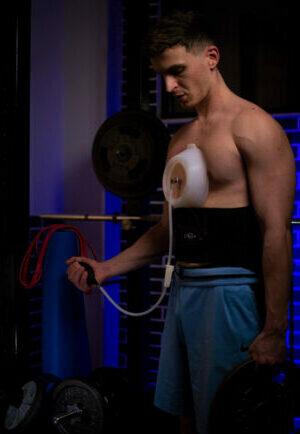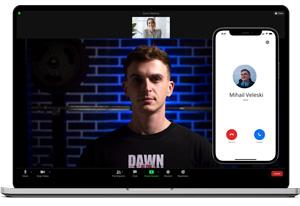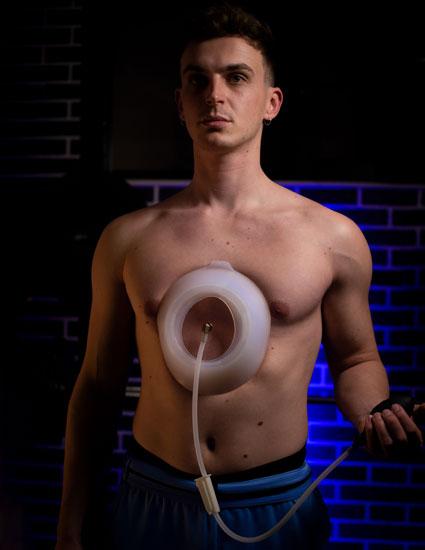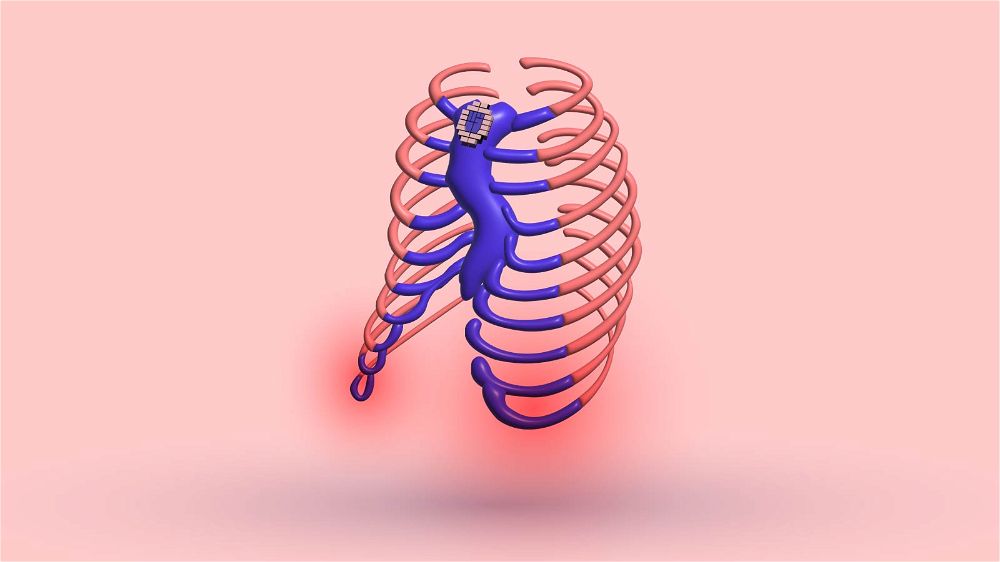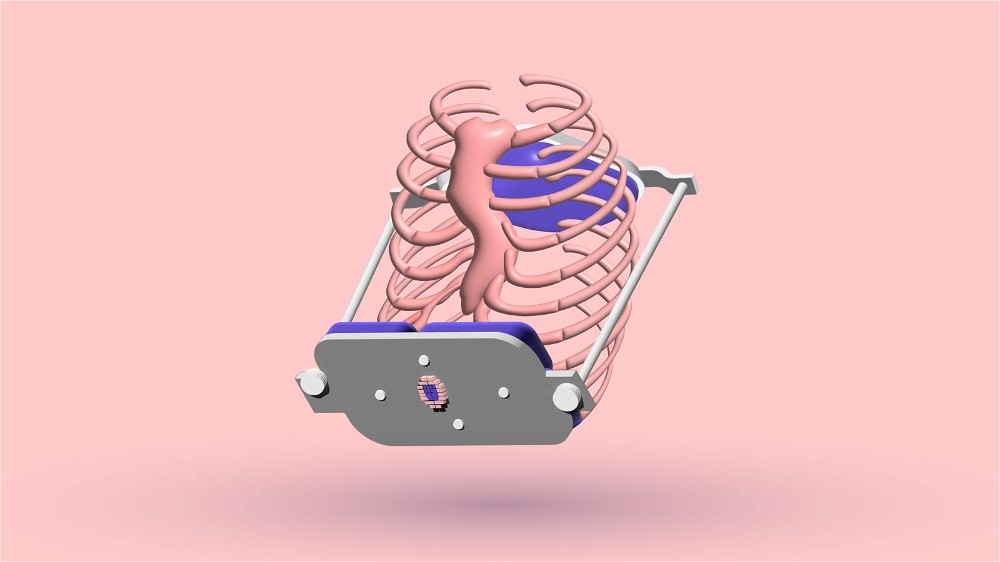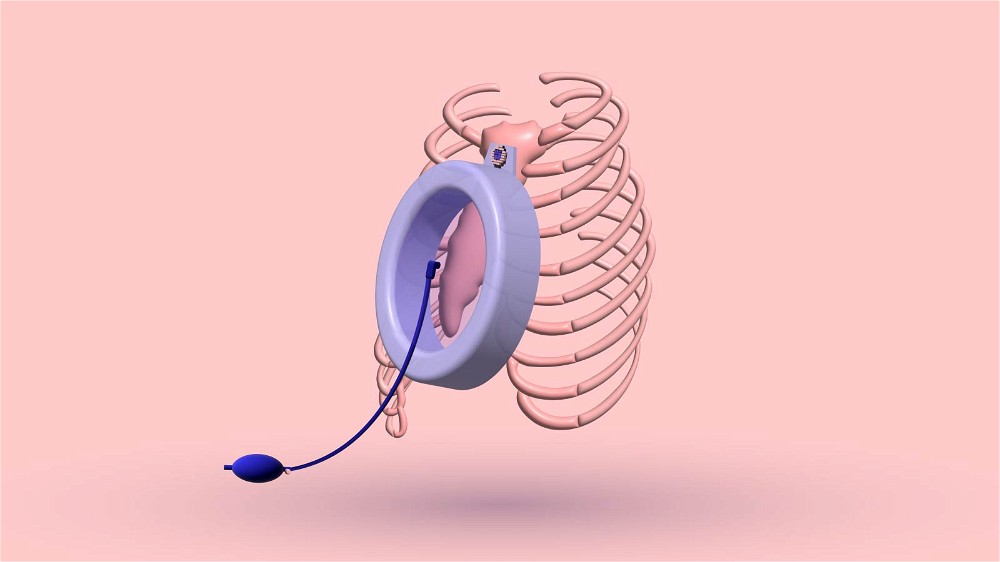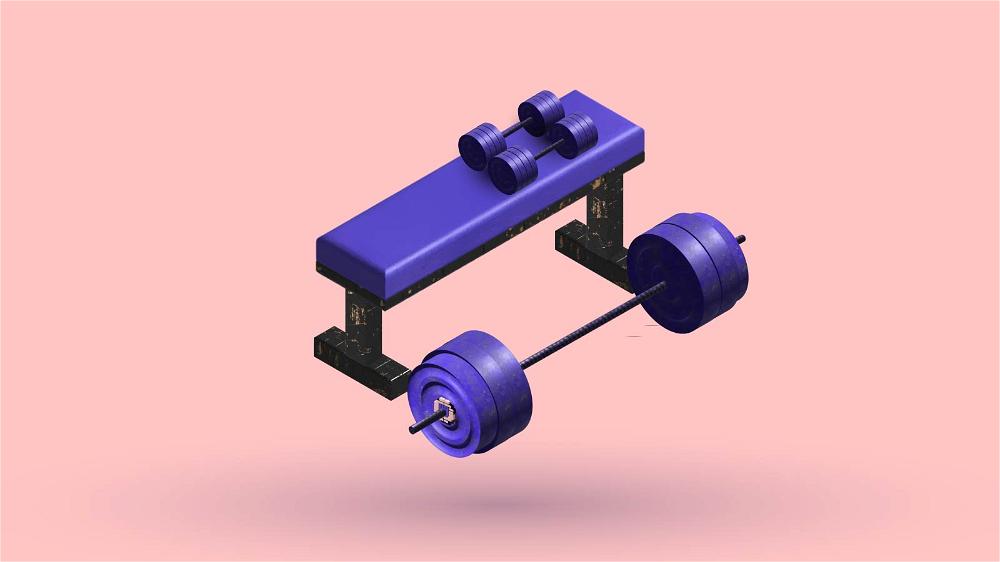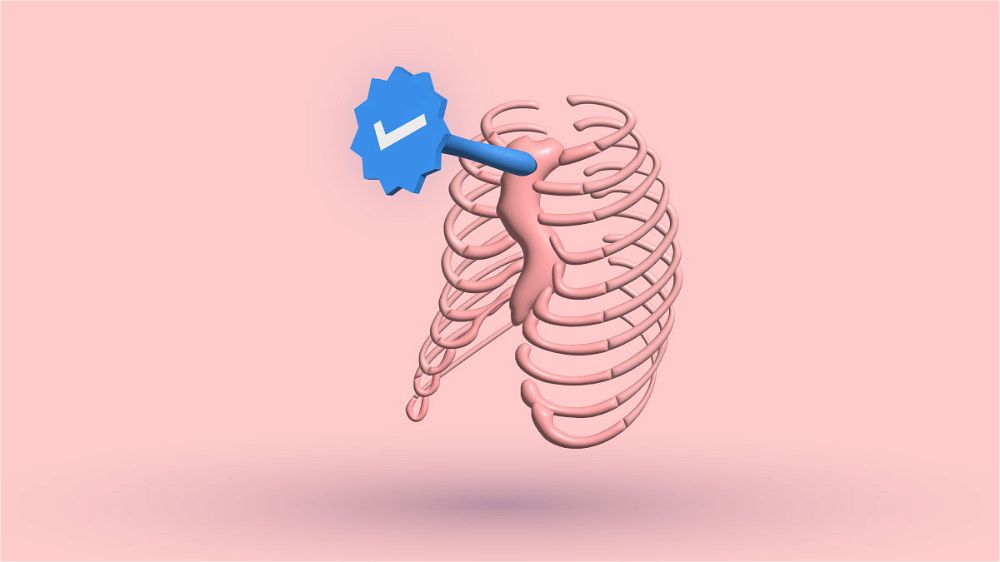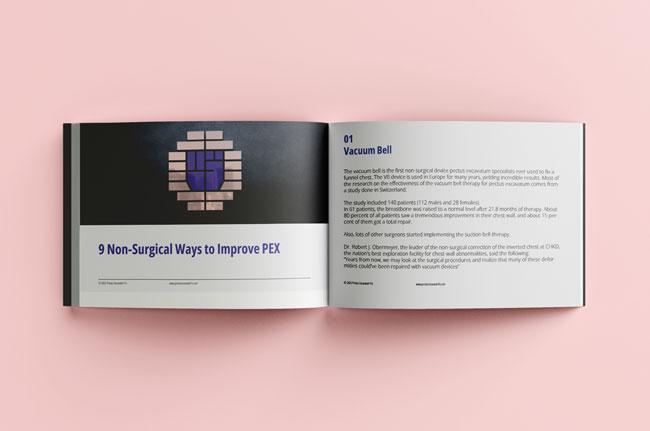- No rib resection
- Shorter procedure time and recovery time
- The scars are minor and almost "invisible."
- Minimal blood loss
- Less pain
- Much smaller cuts
- Faster return to everyday life
Brief Introduction to Pectus Excavatum
Having a chest deformity can decrease the quality of our lives. It can affect our health, mental stability, and overall being. Pectus excavatum is one of the chest bone deformities in which the chest's sternum is sunken. It occurs in response to the unusual growth of many ribs and the breastbone.
The deformity can range from moderate to severe. A severe phase of pectus excavatum deformation might cause cardiac and lung difficulties. It's frequently identified from infancy and especially throughout puberty. It can worsen with age.
The causes of this deformity are still unknown. Scoliosis, Marfan's syndrome, and natural cardiac defects are frequently associated with the pectus excavatum condition.
Retrosternal discomfort, pulsations, a loss in physical capacity, and mental tension are all part of the clinical picture of a patient with pectus excavatum. For someone with this deformity, it may be a difficult period and stressful experience.
Surgery is Widely Used
Depending on many circumstances, people often choose surgery - as a permanent solution for their deformity. We can pick treatment options for our chest bone abnormality thanks to medical advances.
We have a range of different alternatives and options available to us. Whether it's an operative or non-surgical treatment, we have the luxury to choose.
The severity of Deformity & Surgery
Surgery is the most preferred method for people with a higher degree of deformity and additional health problems caused by pectus excavatum.
If the deformity is severe, surgery is needed to fix the deformation and relieve numerous symptoms such as:
- Shortness of breath during activity
- Chest discomfort
- Light-headedness.
It is important to note that surgery will not completely solve the problem if you are still unhappy with your inner self. The constant self-improvement must continue after the operation.
Operation is only the first step towards a brighter and better life; your life is still in your hands, and that is brilliant.
It doesn't have to scare you.
History of the Nuss procedure
Doctor Donald Nuss spent ten years with his colleagues implementing their initial funnel chest surgery in 1998.
With this groundbreaking discovery, the minimally invasive treatment or the Nuss procedure primarily decreased the patient's recovery time and the need for blood replenishment.
These two improvements were the key to a successful surgery.
He questioned other surgical procedures that required cartilage at the sternum-rib junction to be removed since it is already soft and malleable for rebuilding.
With proper modifications, remarkable improvements are noticed in the patients shortly after the surgery.
The successful surgical outcomes and patient satisfaction of this approach were enormous.
The research attempted to explain the advantages of using a minimally invasive surgical method to repair chest deformity. That therapy seeks to correct the deformity by applying pressure to certain parts of the deformed chest.
That method produced far superior outcomes in treating funnel chest malformation in people.
The introduction of minimally invasive surgery characterizes a new therapeutic sense of resolving pectus excavatum. When Donald Nuss, in the 1990s, started to use this surgical method more frequently, this procedure got his name.
Surgical Process
Pectus excavatum is a sternum and rib cartilage depression causing many problems in patients with severe deformation. In those cases, surgical treatment is the best solution for starting a healing journey.
Doctors who see common indications for surgical treatment will suggest a few surgical procedures. With your acceptance, you and your doctor will decide which surgery would be ideal for you.
When Is Nuss Procedure Needed
The deformities with the following clinical symptoms usually need a surgical approach to deal with their deformation.
Common Symptoms
- The deformity progression in the adolescent years
- Abnormal respiratory movement of the wall chest
- Compression or displacement of the heart, and any additional heart problems, as well as cardiac pathology resulting from compression of the heart
- Pulmonary compression, restrictive pulmonary disease, and exhausting breathing problems
*If you're experiencing any of these problems daily, please do not wait any longer and contact your doctors.
Step by Step Nuss Procedure Process
Before Surgery
Your first step will be consulting with your doctors, and together with them, you need to choose your proper treatment. They will require your chest rays to assess whether pectus surgery is the best treatment for you.
After that, the medical team has to tell you everything about your surgical and post-surgical process. Do not be afraid to ask all your questions before deciding to do it.
Ideal Time for Surgery
You must know that the ideal time for surgical treatment is just before puberty. During this time, the chest is still very elastic, and it will be much easier to remodel the chest bone.
Because it is more difficult to bend the sternum of older patients, they will have discomfort and problems. It is best to undergo surgery using the Nuss method when the patient is between 12 to 18.
The period of intensive growth prevents the deformity's deepening and the surgery's recovery time is shorter. At the same time, the incidence of relapse is significantly less.
Safety for Older Patients
А great advantage of this Nuss procedure is that it's safe for people up to thirty years due to the advances in medicine. It is safe because of the compensatory bar bending, a firm bar, and usage of effective analgesics. Results are comparable to those seen in younger patients.
Doctor's Explanation
Before the operation, your doctors should explain everything in detail to you. Of course, if you live far from the hospital, you can do it via video call.
There certainly will be a need for additional examinations before the operation, so you should plan it.
First Physical Examinations
During the first examinations, you'll discuss with the doctors your symptoms due to pectus excavatum. They will ask you about your health prehistory and your aesthetic wishes.
The medical team will tell you all the possible options and potential side effects or problems. You will talk about what to expect from the surgery and the necessity of rehabilitation.
Get Ready Before Surgery
Once all the necessary preparations for the operation are accomplished and done, and you've agreed on a surgery date, you must go to the hospital ready.
Bring essential hygiene items you'll need while in the hospital and carry the necessary documentation. After the blood test is taken before the operation, next is a talk with the anesthesiologist to let them know all the needed information.
Importance of Nutrition
It is also crucial to be careful with your food before the surgery.
By consuming healthy meals, you'll see an improvement in your immunity. With that, your postoperative period can be much easier for you.
Anesthesia
Because the operation requires general anesthesia, it is necessary to do fasting before it. That means not eating the night before the anesthesia and the morning before the scheduled procedure.
Also, in the informative talk with the medical team, you must share all the medicaments you may be taking. They need to know everything for the anesthesia to be successful.
Because the Nuss technique is a harsh medical treatment, it can only perform under general anesthesia. Doctors use excellent epidural analgesia for a speedy recovery following surgery.
After inducing general anesthesia, the epidural (needed for the postoperative period) installs in kids. The best anesthetic for video-assisted thoracoscopy (VATS) required ventilation of one pulmonary wing.
Some anesthesiologists support selective blockage of the diseased lung's main bronchus. The mixture of general anesthesia and a thoracic epidural (for postoperative pain relief) is ideal. General anesthesia is a cocktail of medications that puts you to sleep in preparation for surgery.
You wouldn't feel pain under general anesthesia, and you'll be entirely unconscious. Induction of anesthesia should also include high-dose opioids to limit any discomfort. Doctors use ultrasound guidance for epidural needle and catheter insertion in individuals with additional issues such as scoliosis.
Start of Surgery
When the anesthesia starts working, you will fall asleep, and then the doctors are allowed to begin the operation process. Once you've fallen unconscious, a breathing tube is inserted into the patient's airway to enable each lung to be inflated individually during the operation.
The patient must lie on the back with arms in a 70-degree abduction. The Nuss surgery uses thoracoscopic control to repair deformities. The primary idea behind this procedure is to take advantage of the flexibility of bone-cartilage structures during the patient is in the growing stage.
Lateral Incisions
After the patient is in the wanted position, the surgeon makes two lateral incisions, horizontally or vertically positioned. Incisions are usually with diameters ranging from 2 to 4 cm.
Stakes are placed on the chest sidewalls at the maximum of the deformity's most prominent angle. These incisions serve for the thoracoscope and other equipment to be put in the chest.
Other medical instruments' usage is to remove a portion of the lung and lymph nodes and drain fluid surrounding the lung.
Then, the surgeon inserts the molded metal plate, called the pectus bar, underneath the sunken sternum. It will hold the sternum in a normal position.
The chest cavity will be elevated immediately on the operation table after the insertion of the bar. Thoracoscopy is an essential component of this Nuss surgery.
The thoracoscope camera is usually on the patient's right side, generally below the surgical site. During the Nuss procedure surgery, it is essential to picture every aspect of the process and monitor every possible change.
For a possible injury, surgeons are cautious of intrathoracic organs and constructions because injuring them can be critical when inserting and rotating the metal pectus bar.
Stabilizing the Nuss Bar
After inserting the pectus bars and placing the metal stabilizer, the bars must be secured to the nearest ribs using individual sutures and metal wire.
The stabilizer serves to prevent the movement of the tile and its rotation.
In children under 13 years old, one stabilizer is crucial, while for older two, one each on each side.
How Many Bars
Two pectus bars are necessary for elderly individuals, patients with Marfan syndrome, and those with extensive chest depression.
Sterile Marker Marks
For surgery to be precise and successful, the surgeon marks points on the patient's chest with a sterile marker, which is necessary for the subsequent parts of the operation.
Marks Location
- On the chest
- A break in the sternum area on both sides
- The most curved parts of the ribs
- Intercostal spaces
How Long Until You See Improvement
The kids' chest is more elastic in comparison to older patients. Turning the bar is easy, and the aesthetic impact of the surgery is instantly noticeable.
Adult patients also get visible aesthetic changes in their chests. Still, they must wait a certain amount before having their chests remodeled in the wanted position.
Thoracoscope Removal
Before removing the thoracoscope from the chest, there must be a check for bleeding inside the chest basket.
Then stabilizers mentioned above are installed, one or two depending on the patient's age.
Surgeons will insert a tiny drain in the chest region where the thoracoscope was previously.
Drains remove air from the chest cavity and drainage.
After surgery, patients are in comprehensive, intensive treatment rooms for further healing and pain control.
Prevention of Collapsed Lung
It is necessary to do as soon as possible Chest RTG to determine the eventual appearance of pneumothorax, the medical term for collapsed chest.
If the pneumothorax is significant, drainage is needed.
Surgery is necessary for many, especially those with additional health problems.
However, surgery is crucial for those with mental disorders associated with low self-esteem due to physical appearance.
Waking Up After Surgery
To avoid any potential bar displacement, your waking after the surgery must be smooth, with minimum coughing and movement. You need to be guided by your medical team throughout your waking process.
Also, you have to tell everything you feel after awakening. There is a chance of possible side effects from the anesthesia but speak about your condition to the medical team.
However, a general anesthetic is highly safe. Most people get through it without significant problems, so you don't have to be afraid.
After Surgery Care
Patients are in critical care and receive therapy after surgery. In addition to antibiotic treatments, appropriate analgesia is required, allowing optimal breathing ability first and foremost.
When the patient's health is stable after 2-3 postoperative days, they move to the hospital's other treatment departments.
There they will get continuous medical assistance. Most patients stay in the hospital for 3-5 days on average. During that period, the hospital team will effectively manage postoperative pain.
They will give you physical therapy, such as deep-breathing exercises, and provide recovery guidance. You need to follow the recovery advice from your doctor to get the best results after the surgery.
For your stay in the hospital, I recommend making a list of all the necessary things you might need there before you come. For the stay in the hospital after surgery, have clean pajamas, underwear, towels, and bedding.
If it is a well-equipped hospital, you may not need it, but still, be sure to bring essentials. Also, you must be prepared to care for yourself once you have left the hospital.
In a few weeks, patients can return to their usual activities. Excellent postoperative outcomes are one of the advantages of this Nuss surgical procedure. The visual aspect is breathtaking, making the postoperative period hopeful for you.
Benefits of Nuss Procedure in Post-surgical Recovery Phase
- Reduction of postoperative analgesia
- Reduced blood refund
- Shorter hospitalization period
- Faster recovery and going back to daily activities
Patients undergoing the Nuss procedure will have many follow-up appointments with their doctor to control recovery through the first four weeks after surgery.
Share with your doctor any changes that may have occurred that you may notice. It's essential to follow the movement guidelines given by the doctor. It's crucial to take care of any special instructions you must follow.
Recovery Timeframes in Weeks
First Four Weeks
For the first four weeks following surgery, you should rest. Give your body a chance to relax well and bring back its energy. It is critical to continue following the directions when the discomfort decreases, no matter what.
Remember that it was your choice, and the result, in the end, is what's matters. That is the only way to have a more rapid and successful recovery.
You can usually continue regular daily activities for 4 to 6 weeks following surgery. Still, it would be best to stick to all activity and mobility limitations to stop any possible bar displacement.
6- 12 Weeks
Once you are 6 to 12 weeks into your rehabilitation, patients may return to normal activities and begin with accessible sports to take back their normal health condition.
Try to skip group sports because of the possibility of a potential injury.
However, heavy lifting may be allowed after two months, but still small weights.
Doctors may recommend that patients get back on the track or in the pools after three months because swimming is one of the best solutions for pectus excavatum patients.
Doing some breathing exercises may significantly correct your respiratory system after your surgery.
Your surgeon will give you some advice on the most common breathing exercises. However, still, you can do your research to improve your breathing pattern.
However, you should always follow your doctor's guidance on rehabilitation because it is painful. You'll need some time to go back to your usual lifestyle.
After 12 Weeks
After 12 weeks postoperatively, your doctor may recommend that you return entirely to your normal activities and daily life.
But in most cases, patients that need more time to recover are not forced to sacrifice participating in normal daily activities at this time.
Took your time, and enjoy the healing process.
Know that you've made a hard decision, and now your
well-being is in your hands!
Some forms of exercise and activities may be approved to help chest growth and strengthen the chest muscles during this recovery period.
Some easy yoga moves and special chest exercises can help a lot.
Do some research and try easy home workouts.
Pectus Bar Removal Process
A few years after the Nuss procedure, surgeons should surgically remove the steel support bar if the surgeon thinks your chest is permanently corrected.
The bar supports the chest while it grows and helps it return to its normal position.
It usually stays in place for three or four years.
The removal procedure of the pectus bar is the final step in the repair process.
Besides the usual postoperative controls and RTGs, you need to do one final RPG two years after the operation to determine the evidence for possible removal.
Bar removal depends on the callus formed around the maintaining bar, which holds the chest in the wanted position.
Children under 13 do not develop rapidly, and their bar can remain for up to four years.
The bar removing process is after two years in older kids.
They are going through puberty and are experiencing rapid development in the chest area.
Accordingly, the period in the hospital for the removal procedure may range from a few hours to a few days or up to one week.
Depending on how you will feel on the operation day to remove the pectoral bar, it's possible to go home the same day.
The hardest part is when you are home and your postoperative period starts again.
But, now, you will have more experience and know how to make yourself feel better.
Even though the Nuss procedure is new and minimally invasive and isn't harsh surgery, patients need pain medication and rest after the surgery.
You need to stay at home and rest well for nearly three weeks.
Do's and Don'ts During Recovery
- Do breathing exercises regularly; they can help you relax and expand your breathing capacity.
- Walk or do other gentle yoga exercises to improve your condition and maintain healthy circulation.
- Avoid any hard and harsh activity to minimize possible chances of injury.
- Walking is the best solution for maintaining your figure during recovery and getting enough movement.
- Don't lift heavy things, and try to avoid heavy lifting at the beginning.
- Learn what's best for your treatment and what your body needs.
- Learn a lot about your deformity.
- Be mindful of your overall health.
- And most importantly, check with your doctor if you have any questions about what exercises are safe for you after surgery or any other question about your health.
Parental Guidance List
If you're a parent to a kid undergoing a Nuss procedure, you must remain strong and be there for your kid.
When your child is ready to go home after the operation, you and your child will receive all the needed instructions.
Your doctor will tell you everything about further treatment at home so that you won't be alone on this journey.
Parental Instructions
- When your kid is at home, you must be careful with their correct body posture.
- Please provide them with comfy beds and pillows.
- They must stay home from school for three weeks, so you must consider entertaining activities to keep them active and happy.
- Limited challenging activities for two months are a must, so think about something fun but still passive.
- Long walks are the first to help when your kid needs to free their energy.
- Deep breathing exercises for relaxation purposes twice a day, in the mornings and evenings.
- Showering is possible after ten days of surgery.
- For that purpose, use gentle wet wipes with a pleasant smell.
- They can wear only comfortable clothes, like cotton shirts.
- Keep their body straight at least three months after surgery, making them aware of their proper posture.
- Kids must avoid group and extreme sports six months after surgery for better and safer results.
After a successful surgery and the postoperative path, the child becomes a healthy young individual who can do anything.
Most importantly, they will grow up feeling comfortable in their skin and body.
Another crucial piece of advice and something that I would love to hear as a young individual with a chest deformity is how important it is to exercise.
Try to plant the idea of healthy life in your child and the importance of maintaining habits that will serve them in the future.
List of Important Things About the Surgical Process
- Medical treatment and stay in the hospital are a part of this journey.
- You'll be under general anesthesia.
- The doctor makes two minor cuts on the side of the chest. The scars from the Nuss procedure are much smaller.
- The doctor places one or more pectus bars behind the breastbone and connects them to the outside edge of the ribs.
- The Pectus bar is an essential part of this surgery.
- The doctor uses a tiny camera to get the bars correctly and avoid any displacement or injury.
- The doctor uses the bars to elevate the breastbone to the wanted position.
- A metal plate called a stabilizer, stitches, or wires are placed to hold the bars.
- Depending on your healing journey, the chest is reshaped after about 2–4 years.
- Don't compare yourself to someone else's story and healing path.
- The last essential step is the removal of the bars and going through the postoperative period.
Nuss Procedure Costs
According to some sources, the total cost of pectus excavatum surgery is from $40,000 to $60,000 in the USA.
The same surgery in India will be $10,000-13,500.
This fee includes the cost of the procedure, 2-3 days in the hospital, anesthesia, drugs, and meals during your stay.
However, prices can vary, and the costs covered by the hospital may also vary. Hence, it is best to consult and consider all options before deciding where to do the operation.
For most people, this method of treating pectus excavatum is prohibitively costly.
That is one of the reasons I highly recommend you treat yourself non-surgically if your condition allows that.
Many people have additional problems and do not have the chance to treat themselves with vacuum bells, bracing, or exercise.
The treatment and cost of this procedure determine the individual's state of deformation and progress of it.
Depending on which country and the stage of your deformity, you may pay a different amount for a hospital stay and a Nuss procedure.
The medical team is in charge of all they do for you before, during, and after the operation.
So, your time in the hospital and professional care can be expensive for some people.
As a result, you should plan before choosing the Nuss operation.
Risk of Death
In addition to the numerous advantages of the procedure, there are a few acknowledged flaws.
Serious consequences can be expected, including damage to intrathoracic structures and organs.
Even though the Nuss procedure is a minimally invasive surgical technique, some risks and complications can occur like any surgical operation.
Issues are reported and noted, which are typically usually severe or moderate.
Severe ones cause organ damage and need more complicated surgery after that.
Simple problems can be addressed thoracoscopically, with a cut or drainage, without patients undergoing additional treatments or surgery.
But, it is crucial to talk about problems following bar removal as one of the difficulties, which occurs in 5-10% of instances.
Common Postoperative Complications
- Collapsed lungs are called pneumothorax.
- Bleeding
- Displacement of the pectus bar can be widespread, so you must be very careful throughout your healing process.
- Wound infections, pleural and pericardial infections
- Pneumonia
- Injuries to the intrathoracic organs and structures where the perforations of the heart are especially prominent
- Injury to large blood arteries.
- Risk of death
- Over the last 25 years, there have been relatively few instances of cardiac damage caused by bar placement in the medical literature.
- Six hundred thirty-eight patients completed the Nuss surgery, but those tragedies happen anyways.
An 11-year-old male patient who died after the surgery had experienced ventricular septal fault closure surgery through a sternal incision.
Although incidents like these can happen, the Nuss method has evolved over 20 years.
It has been given top priority among surgical techniques for treating the most common congenital chest deformity, pectus excavatum.
This method's main flaw is the short duration of clinical monitoring of treatment outcomes.
When completing the treatment at particular ages for patients (adults and young adults) and individuals with very expressive musculature, there is still a risk of some consequences and lack of awareness.
That is why I must highlight that this is a serious subject.
Despite the accuracy of the nowadays websites, I advise you to consult the hospital and medical personnel directly when making such decisions.
First and foremost, you must be extremely alert throughout the postoperative period to ensure that you best prepare for the surgery.
With good postoperative care, the risk of complications is minimal.
However, there are dangers associated with every surgical procedure, and you must prepare for anything!
Bleeding and infection, and anesthetic issues are just a few examples of the possible issues.
Bar removal problems are number one in the Nuss procedure.
If you experience any of the following issues, call the doctor immediately!
- Pain that lasts a month or longer
- Feeling that the bars are moving out of the position
- Fluid around the lungs or deflated lungs
Other Common Complications
- Injury to the heart or lungs during surgery.
- Pectus excavatum that reoccurs.
Because there is a chance of pectus excavatum returning, you must continue exercising, stretching, wearing a vacuum bell or Dr. Haje brace, etc.
Being careful about your physical and mental health means doing post-Nuss bar removal workouts, like yoga and walking, even when you feel like you can't do it. Eat healthily. Learn a lot about how to improve your well-being.
Nuss Procedure Scar
The outcome is excellent with this procedure, but it leaves a scar on the chest.
Instead of a traditional vertical sternal scar, this procedure leaves a hardly noticeable lateral scar.
It is not essential to make incisions or remove any ribs, cartilage, or sternum with this Nuss approach.
Look for solutions and treatments for the scar because it is a secondary problem. It doesn't have to stop you from doing the surgery!
Metal Allergy
A frequently asked question about the Nuss procedure is regarding metal allergies.
An allergic reaction to the metal pectus bar placed in the thorax during the procedure is a reported complication by some patients. I briefly reviewed current literature concerning epidemiology, mechanisms, and research results of allergic reactions after Nuss bar implantation.
This allergic response is caused by metals used in the medical implant and affects roughly 2.7 % of individuals.
General or topical glucocorticosteroid therapy can be used to treat those allergic responses. Implant revision, replacement of the steel bar with a titanium one, or removal of the stabilizer can treat extreme allergic reactions.
Although the danger of an allergic response to titanium is reduced, the titanium alternative is not widely utilized. That's because of its higher cost and lower flexibility, making it challenging to fit a stabilizing bar during surgery.
Lung Capacity
Мany patients who have a problem with a more severe form of pectus excavatum also have difficulty breathing.
Rapid and irregular breathing is one of the first signs of pectus.
The Nuss technique did not result in a significant increase in pulmonary function one year after surgery. Still, pectus bar removal resulted in a substantial improvement in long-term postoperative pulmonary function.
Other Surgical Methods
There were numerous different ways to cure pectus excavatum deformity. Doctors have attempted several surgical and conservative remedies to this malformation.
They used to repair the gap of the sternum using synthetic materials that eventually became infected or have a potential danger of infection.
It was provided and then proceeded on to autogenous tissue regeneration.
Doctors with an oblique inframammary incision performed surgeries on older patients, including adolescents.
The front wall of the thorax may crack laterally and fail to cover the opening medially.
The gap reinforces using rib transplantations, which rebuild the thoracic bone without putting pressure on the intrathoracic tissues.
Other chest reconstruction techniques involve "raising" cartilaginous sections of the ribs to connect the gap.
The Sabiston procedure uses rib cartilage incisions to slide throughout the chondrotomy connection of the sternum's foundation, which is then sewn together in a single stitch.
Another lengthening method for the ribs is the displacement of the rib cartilage by dividing the first and third cartilages nearby the centerline and the second and fourth cartilage laterally.
The next step is suturing the first, second, and third with the fourth cartilage.
That makes two long by four short ribs on both sides of the sternum.
Another method goes through a central vertical incision, and that's usually performed on babies.
The holes are mobilized and exposed, and the pericardium and diaphragm detach from subcutaneous tissue and boundaries.
For a full crack, doctors use stainless steel or non-absorbent wires at the unions to resemble the base of the sternum.
The pectoral bone surgeons must cut before it approaches the bases of the sternum to unite partial holes and fused areas.
The medical team must monitor the newborn's cardiac condition throughout the process. They need to ensure that no heart compression occurs before the stitching.
All these methods were left behind when the Ravitch and the Nuss procedure started to show the results.
Nuss vs. Ravitch
Ravitch Procedure
The open repair Ravitch method and the minimally invasive repair with a metal bar known as the Nuss operation are the two most common procedures to fix pectus excavatum.
Ravich made a substantial contribution to the surgical treatment of this malformation.
With the Ravitch procedure, the sternum is osteotomized, the ribs and rib cartilage resected, and the sternum is elevated and stabilized in the proper position.
Following multiple reports on Ravich's technique complexity and the acknowledged challenges that resulted from this open surgical method, many further changes doctors made to get better results.
You can find more information about Ravitch and everything you need to know about this method in my article about the Ravitch procedure.
A temporary metal bar is required to hold the sternum in a raised position.
The support bars removal process is after 6 to 12 months.
The Ravitch technique takes about 4-6 hours to complete.
Nuss Procedure
On the other hand, the benefits of the minimally invasive Nuss procedure are numerous. It is not surprising that the Nuss doctors use it globally.
The Ravitch Treatment causes lower discomfort following the procedure.
However, the Nuss Procedure has a superior aesthetic outcome.
Dr. Hans Pilegaard generally uses the Nuss treatment since it is the best option for patients, even those above 30.
The Nuss method has a shorter operating time and a lower risk of infection and bleeding due to the minimally invasive technique.
Bottom line
The Nuss method is a new, minimally invasive, and safe procedure for surgically repairing a funnel chest.
This Nuss modification with thoracoscopic control enables safe operation and satisfactory results.
The postoperative outcomes are excellent with rare complications.
Patients with pectus carinatum or pectus excavatum can feel self-conscious about their appearance. But, know that there are solutions and ways to heal yourself!
The Nuss procedure can improve chest aesthetics and help with self-esteem.
Although the recovery period can be difficult, most patients are satisfied with the results of this procedure, and that's what matters the most.
Among the benefits, this method is minimally invasive, best reflected postoperatively with barely visible two short cuts on the lateral chest wall, leading to small postoperative scars.
After and before the surgery, you need to exercise, no matter what sports you prefer. Exercising allows you to go through the tough postoperative times easier while leaving you with more body and mind strength.
During the recovery time, do yoga, use vacuum bells, and use any methods and equipment to keep your body posture upright.


